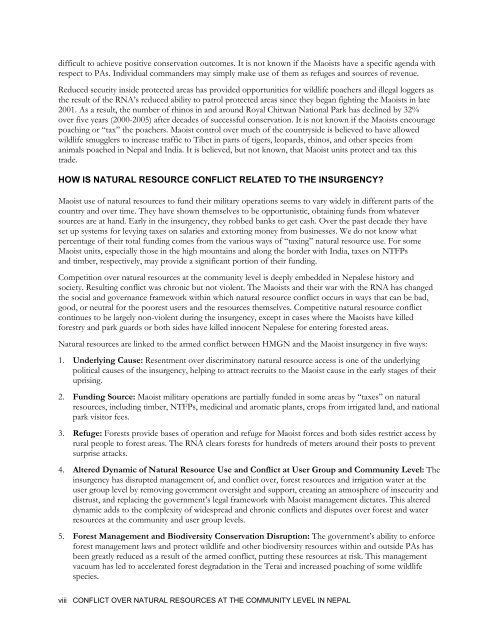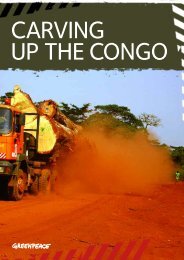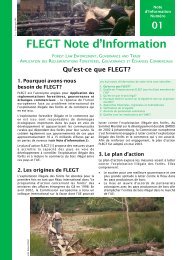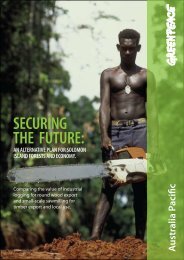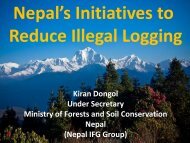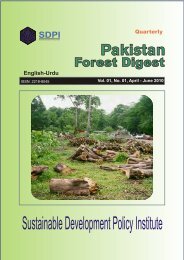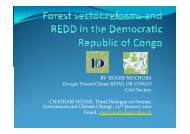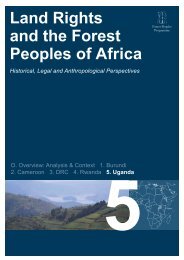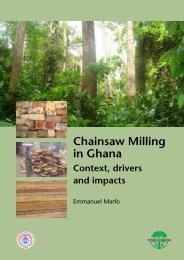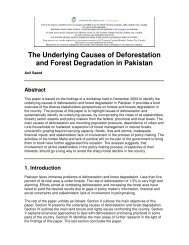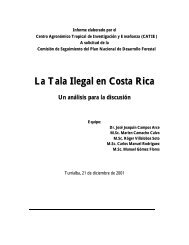conflict over natural resources at the community level in nepal
conflict over natural resources at the community level in nepal
conflict over natural resources at the community level in nepal
You also want an ePaper? Increase the reach of your titles
YUMPU automatically turns print PDFs into web optimized ePapers that Google loves.
difficult to achieve positive conserv<strong>at</strong>ion outcomes. It is not known if <strong>the</strong> Maoists have a specific agenda withrespect to PAs. Individual commanders may simply make use of <strong>the</strong>m as refuges and sources of revenue.Reduced security <strong>in</strong>side protected areas has provided opportunities for wildlife poachers and illegal loggers as<strong>the</strong> result of <strong>the</strong> RNA’s reduced ability to p<strong>at</strong>rol protected areas s<strong>in</strong>ce <strong>the</strong>y began fight<strong>in</strong>g <strong>the</strong> Maoists <strong>in</strong> l<strong>at</strong>e2001. As a result, <strong>the</strong> number of rh<strong>in</strong>os <strong>in</strong> and around Royal Chitwan N<strong>at</strong>ional Park has decl<strong>in</strong>ed by 32%<strong>over</strong> five years (2000-2005) after decades of successful conserv<strong>at</strong>ion. It is not known if <strong>the</strong> Maoists encouragepoach<strong>in</strong>g or “tax” <strong>the</strong> poachers. Maoist control <strong>over</strong> much of <strong>the</strong> countryside is believed to have allowedwildlife smugglers to <strong>in</strong>crease traffic to Tibet <strong>in</strong> parts of tigers, leopards, rh<strong>in</strong>os, and o<strong>the</strong>r species fromanimals poached <strong>in</strong> Nepal and India. It is believed, but not known, th<strong>at</strong> Maoist units protect and tax thistrade.HOW IS NATURAL RESOURCE CONFLICT RELATED TO THE INSURGENCY?Maoist use of <strong>n<strong>at</strong>ural</strong> <strong>resources</strong> to fund <strong>the</strong>ir military oper<strong>at</strong>ions seems to vary widely <strong>in</strong> different parts of <strong>the</strong>country and <strong>over</strong> time. They have shown <strong>the</strong>mselves to be opportunistic, obta<strong>in</strong><strong>in</strong>g funds from wh<strong>at</strong>eversources are <strong>at</strong> hand. Early <strong>in</strong> <strong>the</strong> <strong>in</strong>surgency, <strong>the</strong>y robbed banks to get cash. Over <strong>the</strong> past decade <strong>the</strong>y haveset up systems for levy<strong>in</strong>g taxes on salaries and extort<strong>in</strong>g money from bus<strong>in</strong>esses. We do not know wh<strong>at</strong>percentage of <strong>the</strong>ir total fund<strong>in</strong>g comes from <strong>the</strong> various ways of “tax<strong>in</strong>g” <strong>n<strong>at</strong>ural</strong> resource use. For someMaoist units, especially those <strong>in</strong> <strong>the</strong> high mounta<strong>in</strong>s and along <strong>the</strong> border with India, taxes on NTFPsand timber, respectively, may provide a significant portion of <strong>the</strong>ir fund<strong>in</strong>g.Competition <strong>over</strong> <strong>n<strong>at</strong>ural</strong> <strong>resources</strong> <strong>at</strong> <strong>the</strong> <strong>community</strong> <strong>level</strong> is deeply embedded <strong>in</strong> Nepalese history andsociety. Result<strong>in</strong>g <strong>conflict</strong> was chronic but not violent. The Maoists and <strong>the</strong>ir war with <strong>the</strong> RNA has changed<strong>the</strong> social and g<strong>over</strong>nance framework with<strong>in</strong> which <strong>n<strong>at</strong>ural</strong> resource <strong>conflict</strong> occurs <strong>in</strong> ways th<strong>at</strong> can be bad,good, or neutral for <strong>the</strong> poorest users and <strong>the</strong> <strong>resources</strong> <strong>the</strong>mselves. Competitive <strong>n<strong>at</strong>ural</strong> resource <strong>conflict</strong>cont<strong>in</strong>ues to be largely non-violent dur<strong>in</strong>g <strong>the</strong> <strong>in</strong>surgency, except <strong>in</strong> cases where <strong>the</strong> Maoists have killedforestry and park guards or both sides have killed <strong>in</strong>nocent Nepalese for enter<strong>in</strong>g forested areas.N<strong>at</strong>ural <strong>resources</strong> are l<strong>in</strong>ked to <strong>the</strong> armed <strong>conflict</strong> between HMGN and <strong>the</strong> Maoist <strong>in</strong>surgency <strong>in</strong> five ways:1. Underly<strong>in</strong>g Cause: Resentment <strong>over</strong> discrim<strong>in</strong><strong>at</strong>ory <strong>n<strong>at</strong>ural</strong> resource access is one of <strong>the</strong> underly<strong>in</strong>gpolitical causes of <strong>the</strong> <strong>in</strong>surgency, help<strong>in</strong>g to <strong>at</strong>tract recruits to <strong>the</strong> Maoist cause <strong>in</strong> <strong>the</strong> early stages of <strong>the</strong>irupris<strong>in</strong>g.2. Fund<strong>in</strong>g Source: Maoist military oper<strong>at</strong>ions are partially funded <strong>in</strong> some areas by “taxes” on <strong>n<strong>at</strong>ural</strong><strong>resources</strong>, <strong>in</strong>clud<strong>in</strong>g timber, NTFPs, medic<strong>in</strong>al and arom<strong>at</strong>ic plants, crops from irrig<strong>at</strong>ed land, and n<strong>at</strong>ionalpark visitor fees.3. Refuge: Forests provide bases of oper<strong>at</strong>ion and refuge for Maoist forces and both sides restrict access byrural people to forest areas. The RNA clears forests for hundreds of meters around <strong>the</strong>ir posts to preventsurprise <strong>at</strong>tacks.4. Altered Dynamic of N<strong>at</strong>ural Resource Use and Conflict <strong>at</strong> User Group and Community Level: The<strong>in</strong>surgency has disrupted management of, and <strong>conflict</strong> <strong>over</strong>, forest <strong>resources</strong> and irrig<strong>at</strong>ion w<strong>at</strong>er <strong>at</strong> <strong>the</strong>user group <strong>level</strong> by remov<strong>in</strong>g g<strong>over</strong>nment <strong>over</strong>sight and support, cre<strong>at</strong><strong>in</strong>g an <strong>at</strong>mosphere of <strong>in</strong>security anddistrust, and replac<strong>in</strong>g <strong>the</strong> g<strong>over</strong>nment’s legal framework with Maoist management dict<strong>at</strong>es. This altereddynamic adds to <strong>the</strong> complexity of widespread and chronic <strong>conflict</strong>s and disputes <strong>over</strong> forest and w<strong>at</strong>er<strong>resources</strong> <strong>at</strong> <strong>the</strong> <strong>community</strong> and user group <strong>level</strong>s.5. Forest Management and Biodiversity Conserv<strong>at</strong>ion Disruption: The g<strong>over</strong>nment’s ability to enforceforest management laws and protect wildlife and o<strong>the</strong>r biodiversity <strong>resources</strong> with<strong>in</strong> and outside PAs hasbeen gre<strong>at</strong>ly reduced as a result of <strong>the</strong> armed <strong>conflict</strong>, putt<strong>in</strong>g <strong>the</strong>se <strong>resources</strong> <strong>at</strong> risk. This managementvacuum has led to acceler<strong>at</strong>ed forest degrad<strong>at</strong>ion <strong>in</strong> <strong>the</strong> Terai and <strong>in</strong>creased poach<strong>in</strong>g of some wildlifespecies.viii CONFLICT OVER NATURAL RESOURCES AT THE COMMUNITY LEVEL IN NEPAL


